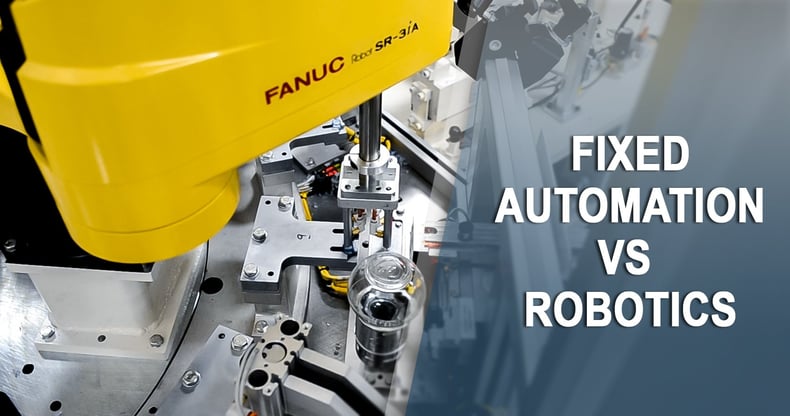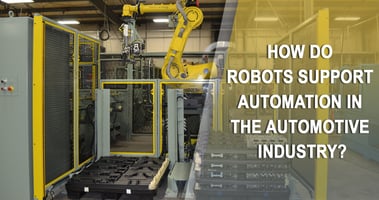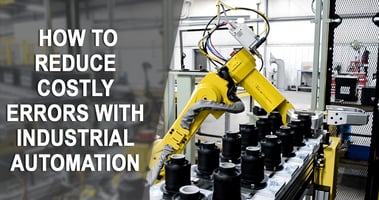When it comes to leveraging robotic applications to enhance automated operations, the automotive...
Robotics vs. Fixed Automation in Manufacturing Environments

The manufacturing industry has undergone immense transformation in the last few decades, propelled largely by the ongoing advancement of automation opportunities. In fact, technology is quickly refashioning how manufacturing companies operate their entire businesses.
From increased quality and productivity to lower operational costs, as well as safer workplace conditions and greater bandwidth to focus on more strategic functions, automation has the potential to reap major benefits for organizations in the manufacturing world. Even so, many companies find it difficult to identify which automation solutions are best suited to meet their unique needs.
One of the most common challenges revolves around the decision to leverage robotics or fixed automation in a specific manufacturing environment. To help shed light on the subject, this article addresses some of the most important differences between robotics and fixed automation, including expert insight on when and how the two can be most effectively utilized by manufacturing facilities.
Defining Automation on Two Levels
In its broadest sense, manufacturing automation involves the use of machines and/or other technology to carry out production tasks and functions that would otherwise be performed by human workers. Automation has been embraced by a wide range of manufacturing companies, including industries such as:
- Utilities and infrastructure
- Pharma
- Healthcare
- Food and beverage
- Automobile
Fixed automation, in more specific terms, relies on machines and technology designed for finite processes and specs. Let’s say, for example, that your company produces widgets. You’ve been manufacturing these widgets—all of uniform size and composition—for 20-some years, and you plan to continue making this product well into the foreseeable future. Fixed automation enables you to create immense efficiency within your repeatable production processes, as well as slash operational costs and facilitate greater accuracy. These solutions are developed and built for a dedicated purpose and are not easily applied to other production needs.
Robotics systems, on the other hand, introduce the element of flexibility into the automation equation. For organizations requiring a more fluid manufacturing process, robotics provide the opportunity to accommodate changes and repurpose automation solutions for fluctuating needs. Robots can be programmed to perform multiple functions for products of varying sizes and materials. Consider, for instance, a company palletizing bags of livestock feed. Although most bags today weigh less than 50 pounds, bag sizes change frequently so the company must accommodate accordingly. In this case, a robotics approach could support the flexibility of the automation to shift palletizing based on bag size.
It’s important to remember that both robotics and fixed automation serve different purposes and should be selected based entirely on your facility’s specific goals. Here’s a more detailed breakdown of how the two diverge in terms of individual manufacturing needs.
6 Essential Considerations for Robots and Fixed Automation
1. Cost Analysis
Generally speaking, fixed automation solutions are less expensive than robots. However, it’s important to factor in your individual requirements because the total cost of ownership is usually a more informative figure than just the upfront investment in technology and machinery. Fundamental to understanding overall cost is recognizing the long-term savings.
2. Integration and Implementation
Robotics solutions are often easier to integrate and implement. With hard automation, it might take a few days to get everything perfectly aligned and functioning optimally. Whereas, with a robot, the solution can be tweaked with programming (much faster than it takes to rework hard automation processes) to accommodate the manufacturing environment’s specific integration needs.
3. Reliability and Maintenance
By choosing a robotic solution over fixed automation, your potential failures are minimal. The mean-time-between-failure of a FANUC robot, for example, is documented at approximately seven years, depending on the model. That robot will most likely be the most robust piece of equipment on your factory floor. Robotics are also easier to maintain, given that fixed automation comprises many more sensors, valves, devices and components than a single robot. Essentially, there are significantly more potential failure points with fixed automation.
4. User Complexity
Robotics should be a simpler solution to operate than fixed automation—that is, when it is integrated properly (otherwise, this might not be the case). Quality integrators build their robotics systems in such a way that operators have no need to touch the actual robot, but rather utilize a touchpad for all controls. This alleviates a great deal of complexity for the end user.
5. Speed
There are definitely some fixed automation solutions with a level of speed that robots simply can’t match. This is a common occurrence in food manufacturing, where a number of processes are performed with fixed automation operating at incredible speeds. Even so, there are many facilities that recognize the value of integrating fast fixed automation in certain areas in addition to more flexible robotics solutions in others.
6. Flexibility
If you’re buying a piece of capital equipment, you’re most likely planning to use it for 10 to 15 years down the road. In many cases, manufacturing companies are more comfortable investing in an asset that has the flexibility to be used for multiple applications, as opposed to being locked into just one. Robots carry the distinct advantage in this area, given their capacity to be reprogrammed, retooled and applied in a much more variable way.
What’s the Best Choice for Your Manufacturing Needs?
There’s no quick, easy answer to the question of whether you should opt for robotics, fixed automation or a combination of both in your manufacturing facility. But there is a clear path forward in making the most informed decision, and it all starts with identifying your business goals. These objectives will serve as the basis for formulating a smart automation plan.
Consider partnering with an integrator who will work to understand and accommodate your goals before designing an automation system that fully supports them. Whether you already have detailed specifications for a project or you’re looking for an expert to develop a plan based on your cycle times, product information and overall business objectives, an experienced integrator like Wauseon Machine has the knowledge and expertise to make your integration a successful one.



